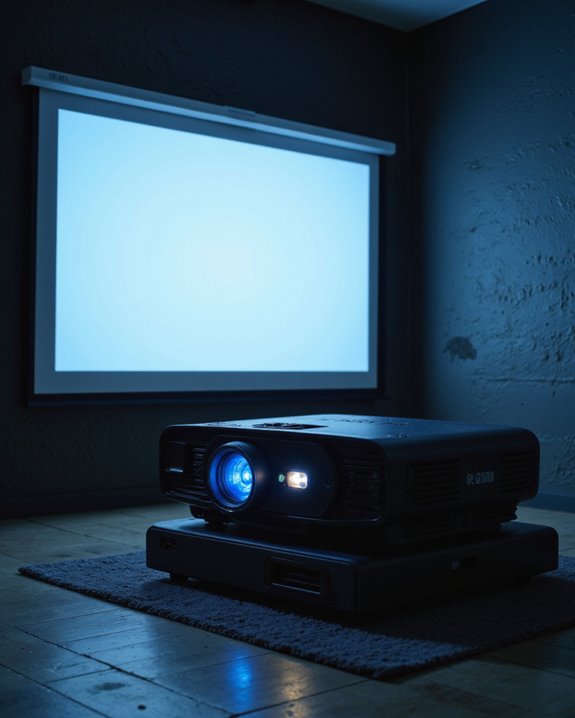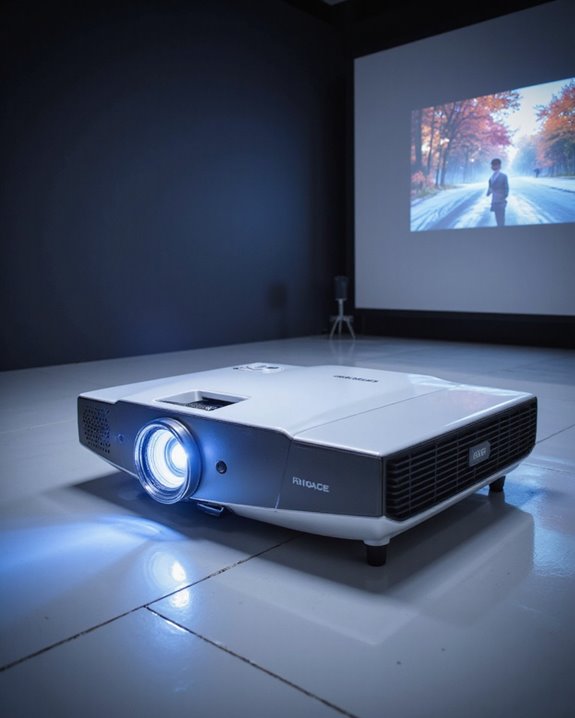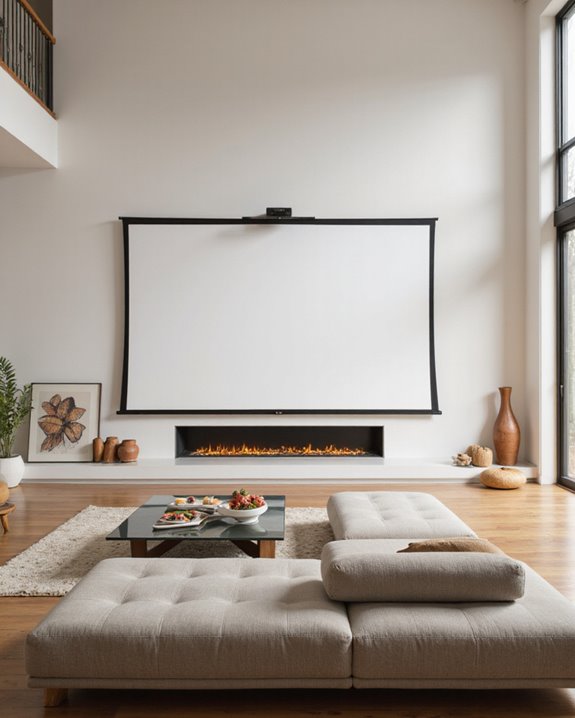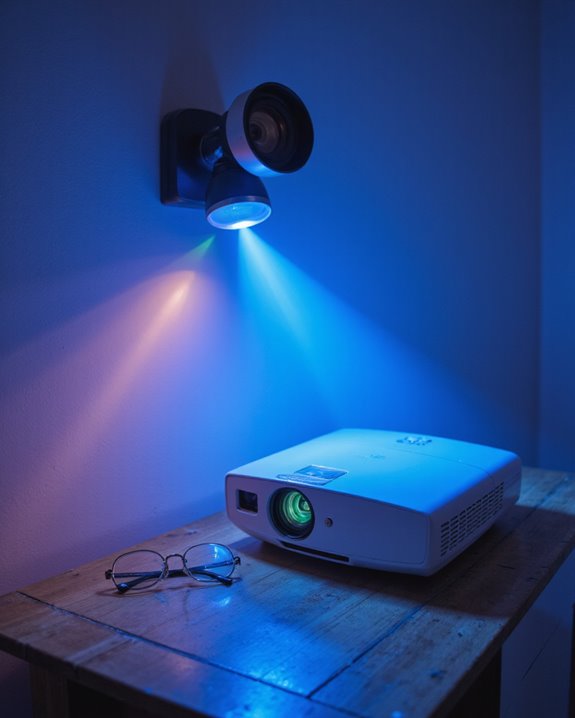Projectors can overheat due to poor ventilation, blocked vents, dust accumulation, and extended use beyond 5-6 hours. Common warning signs include bright warning lights, loud fan operation, decreased image quality, and automatic shutdowns. Prevention requires proper placement in well-ventilated areas, regular cleaning of filters and vents, and maintaining appropriate room temperatures. High altitude environments above 1,000 meters require special cooling modes for peak performance. Understanding these factors helps guarantee long-term projector reliability and performance.
Key Takeaways
- Projectors can overheat due to poor ventilation, blocked air vents, dust accumulation, and prolonged use beyond 5-6 hours without breaks.
- Warning signs include bright warning lights, loud fan operation, decreased brightness, automatic shutdowns, and the projector feeling hot near vents.
- High-wattage lamps generate substantial heat, which becomes problematic when combined with restricted airflow and high ambient room temperatures.
- Regular cleaning of filters, proper ventilation, maintaining room temperature, and using eco-mode help prevent projector overheating issues.
- Install projectors away from walls, avoid enclosed spaces, and activate High Altitude Mode above 1,000 meters for optimal heat management.
Understanding Projector Overheating Basics
When a projector begins to overheat, understanding the fundamental causes and warning signs becomes essential for preventing damage to the device. Poor ventilation and high ambient temperatures are primary factors that affect power consumption and overall performance. The projector’s internal components, including those responsible for color calibration, can suffer significant stress when operating in confined spaces or dusty environments. Most projectors will shut down within 5-30 seconds of detecting dangerous heat levels to protect internal components.
Several key factors contribute to projector overheating:
- Blocked air vents restricting proper airflow
- Dirty or clogged filters impeding ventilation
- Extended operation without breaks
- Inadequate spacing around the unit
Environmental conditions also play a pivotal role in heat management. Operating a projector in rooms with poor air circulation or high humidity levels can accelerate the overheating process, potentially leading to system failure or permanent damage. Additionally, using a projector with insufficient brightness for the ambient light levels can cause it to work harder, increasing heat generation. Proper ventilation systems and regular maintenance are crucial for preventing overheating and ensuring long-term performance.
Common Signs Your Projector Is Running Too Hot

Recognizing the warning signs of an overheating projector can prevent costly damage and extend the device’s lifespan. Several indicators suggest a projector is running too hot, even when basic projector installation tips have been followed correctly.
The most immediate signs include warning lights on the device’s display panel and unusually loud fan operation. Users may notice the projector feels hot to the touch, particularly near the ventilation areas. Performance issues often follow, such as decreased image brightness or unexpected shutdowns. While remote control troubleshooting might seem like a solution, these symptoms typically indicate internal temperature problems. Operating your projector in a normal room temperature environment between 68-77°F helps prevent these issues from occurring. Additionally, poor ventilation or blocked air filters can significantly contribute to overheating, emphasizing the importance of proper ventilation maintenance.
Physical signs include the projector automatically powering off to prevent damage, along with erratic behavior of the power LED. Some models may display specific error messages related to lamp temperature or system overheating.
Major Causes of Projector Heat Buildup
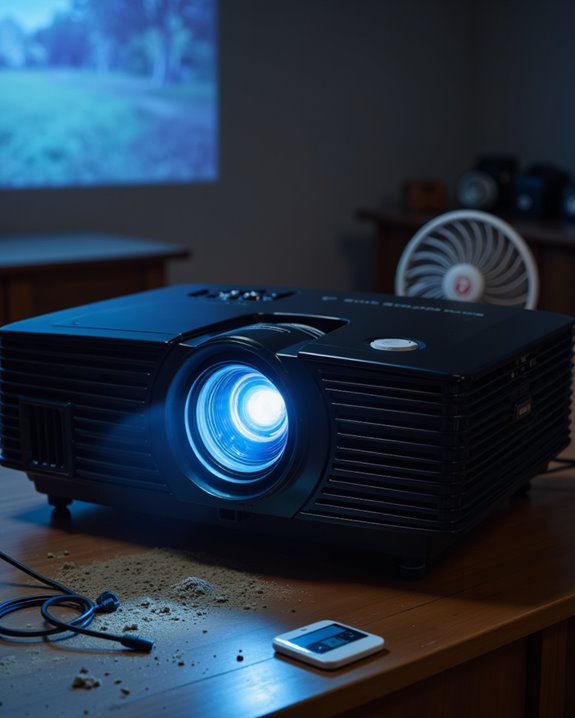
Several critical factors contribute to excessive heat buildup in modern projectors, with each presenting unique challenges for maintaining ideal operating temperatures. The primary source is high-wattage lamps, which sacrifice lighting efficiency for brightness, generating substantial heat during operation. Extended use beyond 5-6 hours overwhelms the projector’s ventilation design, leading to dangerous temperature increases. Experts recommend allowing adequate cooling periods of at least 20 minutes between extended usage sessions to prevent overheating issues. Poor mounting positions and restricted airflow compound these issues, especially in ceiling installations where heat gets trapped. Dust accumulation in vents and internal components severely impacts cooling effectiveness, while inadequate maintenance allows these problems to worsen over time. Environmental factors, such as ambient room temperature and enclosed spaces, further challenge the projector’s ability to maintain safe operating temperatures, particularly during extended use periods.
Essential Prevention Strategies for Projector Overheating
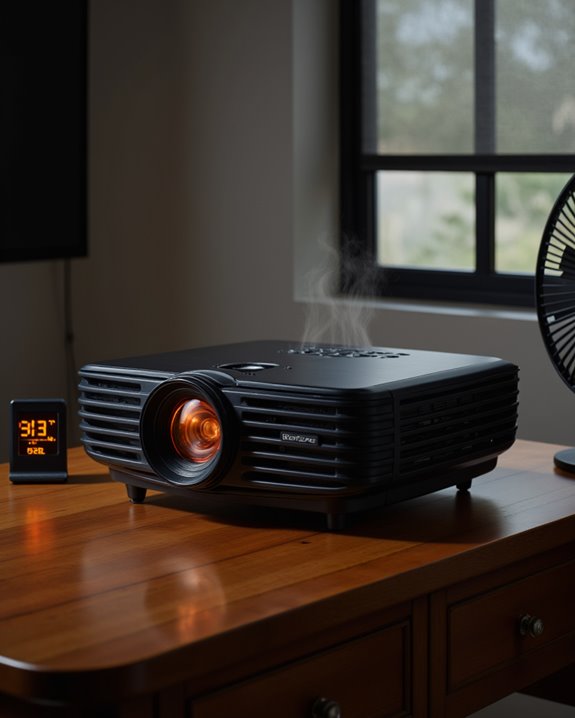
Preventing projector overheating requires a systematic approach that addresses the major causes of heat buildup. Proper projector placement plays a vital role, starting with positioning the device in well-ventilated areas away from walls and heat sources. The placement should allow for unrestricted airflow around all sides of the unit. Direct sunlight exposure should always be avoided to prevent unnecessary heat absorption.
Effective ventilation techniques further protect against overheating. These include regular cleaning of air filters, using cooling fans designed specifically for projectors, and maintaining ideal room temperature. Additional preventive measures include:
- Operating the projector in eco-mode when possible
- Taking periodic breaks during extended use
- Installing external cooling systems in high-use environments
- Monitoring ambient temperature and humidity levels
- Scheduling regular maintenance checks to guarantee all cooling components function properly
Advanced solutions like thermal electric coolers can provide extra protection for professional installations.
High Altitude Effects on Projector Performance
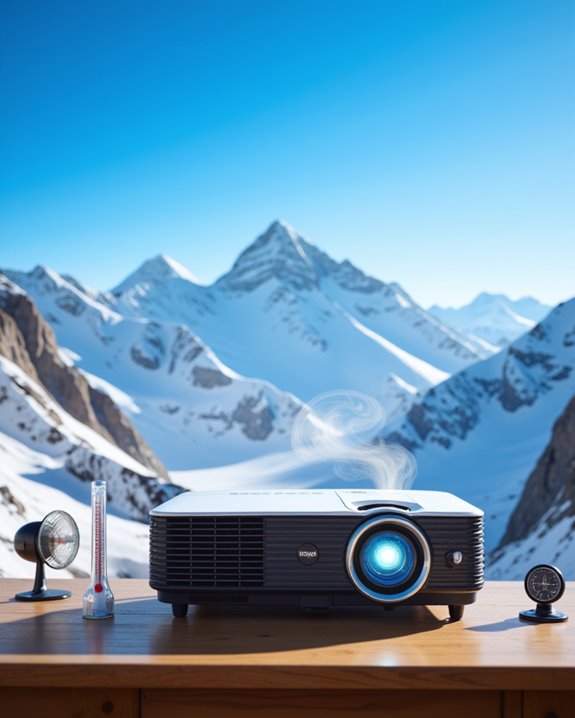
When projectors operate at high altitudes above 1,000 meters (3,280 feet), they face unique challenges due to reduced air pressure and environmental factors. The altitude impact markedly affects cooling efficiency, as thinner air reduces the projector’s ability to dissipate heat effectively. Since 56.2% of Earth’s population lives below 200 meters elevation, most projectors are optimized for operation at lower altitudes.
To combat these challenges, many modern projectors include a High Altitude Mode, which adjusts internal fan speeds to compensate for the reduced air density. This specialized setting becomes essential when ambient temperature combines with altitude-related issues, potentially leading to overheating. Users must activate this mode when operating projectors at elevations between 1,000 to 1,800 meters, depending on the specific model. Failure to use appropriate altitude settings can result in component damage, reduced performance, and premature equipment failure due to inadequate cooling and environmental stress.
Advanced Cooling Technologies and Solutions

Modern projector systems rely heavily on advanced cooling technologies to maintain ideal operating temperatures and prevent performance issues. Recent cooling innovations have introduced sophisticated thermal management solutions, including thermoelectric cooling systems that can handle temperature differentials up to 72°C.
Leading manufacturers now implement multiple cooling approaches:
- Thermoelectric coolers that use the Peltier effect for precise spot-cooling
- Two-phase heat transfer systems for specialized thermal control
- Ambient liquid systems combined with thermoelectric technology
- Energy-efficient recirculating chillers for complex setups
These solutions address common challenges like high power density and dust accumulation while improving overall system reliability. Companies like Advanced Cooling Technologies continue developing more efficient cooling methods, with recent breakthroughs showing up to 10% performance improvements in thermoelectric materials. Through their commitment to value-engineered products, ACT consistently delivers innovative thermal management solutions that maximize projector performance and longevity.
Best Practices for Long-Term Projector Heat Management

Effective long-term heat management stands as a critical factor in extending projector lifespan and maintaining ideal performance. Regular maintenance combines with strategic installation to create optimal operating conditions. By selecting locations with natural airflow optimization and using heat resistant materials in mounting areas, owners can substantially reduce thermal stress on their devices. Utilizing a combination of active and passive cooling methods provides comprehensive temperature control for maximum effectiveness.
Key practices include:
- Maintaining clean ventilation ports and filters
- Installing projectors in well-ventilated spaces away from heat sources
- Implementing scheduled rest periods during extended use
- Monitoring ambient temperature levels
- Using power-saving modes when full brightness isn’t required
Proper positioning also plays a vital role, with elevated mounts and open shelving providing better air circulation. Regular professional maintenance ensures internal components remain dust-free and cooling systems function efficiently, protecting the projector’s long-term reliability.
Frequently Asked Questions
Can Projector Overheating Permanently Damage Other Electronic Devices Nearby?
Projector overheating typically poses minimal risk to nearby electronics. While projectors can generate heat, they don’t cause significant electronic interference or power surges that would permanently damage surrounding devices when operating normally.
How Long Does It Take for an Overheated Projector to Cool Down?
Like a kettle slowly releasing its steam, projector cooling time typically ranges from 15-30 minutes. Temperature recovery varies based on the model, ventilation conditions, and ambient temperature, with some units requiring longer periods.
Should I Use External Fans to Cool My Projector?
External fans can be effective cooling methods for projectors, but they should be considered supplementary rather than primary solutions. Fan effectiveness depends on proper placement and airflow management without introducing excessive noise or vibration.
Do LED Projectors Overheat Less Than Traditional Lamp-Based Projectors?
Like comparing a gentle breeze to a blazing fire, LED projectors generate markedly less heat than traditional lamp-based units. Their superior LED longevity and reduced need for lamp replacements make them inherently less prone to overheating.
Can Extreme Cold Temperatures Affect Projector Performance Similar to Overheating?
Yes, extreme cold impact on projectors can cause performance issues similar to overheating. Cold temperatures disrupt temperature stability, leading to condensation, delayed startups, unstable displays, and potential damage to internal components.


